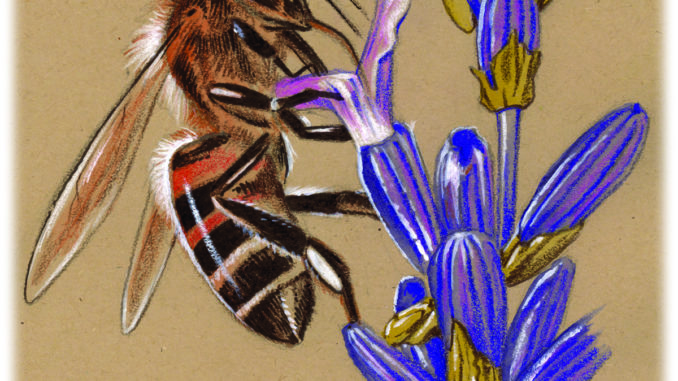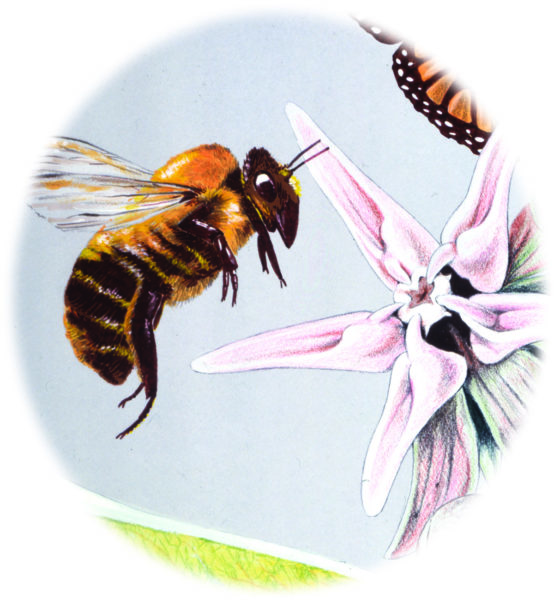
By R. Gary Raham
A bee’s “spring thing”—actually, all summer thing—is pollination, although the bee just thinks it’s getting a good meal. Plants lay out an enticing banquet to coerce the bees into fulfilling their sex lives. Pollinators of one sort or another (mostly insects, birds, and bats) are crucial for about a third of the world’s food crops and 90% of wild flowering plants, according to the NRDC (Natural Resources Defense Council).
Say “bee” and most people think of the honeybee, Apis mellifera, a European bee that humans imported to this side of the pond about 300 years ago. Honeybees are crucial for approximately 14% of agricultural crops, especially fruits, certain vegetables, and nuts. But the 3,000 or so species of wild bees in North America determine the reproductive fate of 90% of wild flowering plants. (Cornell is active in researching wild bee pollination services: https://entomology.cals.cornell.edu/extension/wild-pollinators/) Keeping both wild and domesticated bees alive and healthy will serve our important needs too.
Students in Colorado State University’s bee clubs have some great ideas for helping domestic bees. Christina Geldert, a first-year student in the Doctor of Veterinary Medicine Program, and Arathi Seshadri, special assistant professor in the College of Agricultural Sciences, put together a list of tips and a helpful youtube video. (https://www.youtube.com/watch?v=zC3-BG8sc8A&t=1s) Students insulate the hives with black tar paper from October to late November, leave some honey in the hive (about 80-100 lbs.), because bees remain active and need to eat during cold months, and replace sugar water as needed. On warmer days they also allow bees to forage on their own. Bee keepers can remove insulation in February or March, depending on conditions. Seshadri’s research deals with ways to improve pollinators’ health.
Honeybees maintain their colonies all year long. Wild bees, like bumblebees, live their colonial lives differently. Colorado is home to 16 different species of bumblebee—those hairy, beer-belly bees with bold swatches of black, yellow, and (sometimes) orange. While their lifestyles may vary in some details, the basics remain the same. Queen bees that mated the previous fall represent the only survivors of the previous year’s colony. They dig a few inches into the soil or maybe a nice compost heap, and hibernate during cold winter months. They awaken in spring to search out a likely nesting site. An abandoned rodent burrow serves nicely. Initially, the lonely queen lays her fertilized eggs, feeds her hatching young with nectar and pollen, and waits for them to grow up and take over the labors. The first brood consists of somewhat underfed females, not as big as their mother.
Bumblebee colonies tend to number in the hundreds, rather than the tens of thousands typical of honeybees. They become generalist pollinators that visit a wide variety of plants. Flowers in the pea family, like milkvetch, produce big landing pad petals that invite bumblebees to settle in for a good feed. At the end of the summer into fall some males hatch from their eggs. Males mate with late season queens that grow stout and will overwinter to start the cycle again.

The Xerces Society for Invertebrate Conservation provides some good tips for helping out bumblebees. (http://xerces.org/learn-about-bumble-bees/) In the spring and early summer, include a diversity of early-blooming plants in your landscape. To protect overwintering queens, avoid early raking and mowing. Keep large patches of land unmowed and untilled to provide potential nesting sites. Avoid the use of pesticides when queens are still foraging and their colonies are small.
In summer into fall, mid and late blooming plants like milkweed and goldenrod provide a good source of nectar and pollen. Leave enough downed wood and leaf litter to provide potential overwintering sites. Select pesticides less harmful to bees and avoid applying them during the times when bees are active.
Late fall and winter are the best times for mowing. Cut with the mower deck at the highest safe level to avoid disturbing overwintering queens. Leave untilled ground where you can. Small controlled burns are okay, but leave some unburned patches as animal refuges. Winter is the best time for targeted herbicide treatment for invasive species.
Bees help teach us that we are all in this game of life together. They help feed us, as long as we help them survive and thrive.
Support Northern Colorado Journalism
Show your support for North Forty News by helping us produce more content. It's a kind and simple gesture that will help us continue to bring more content to you.
BONUS - Donors get a link in their receipt to sign up for our once-per-week instant text messaging alert. Get your e-copy of North Forty News the moment it is released!
Click to Donate